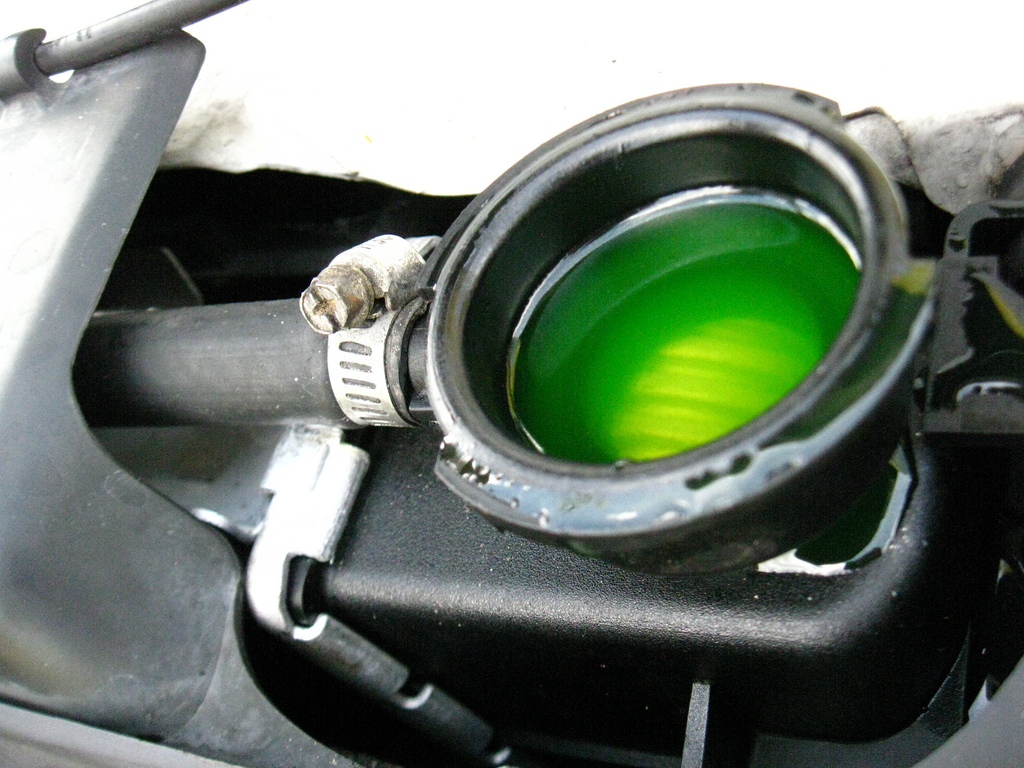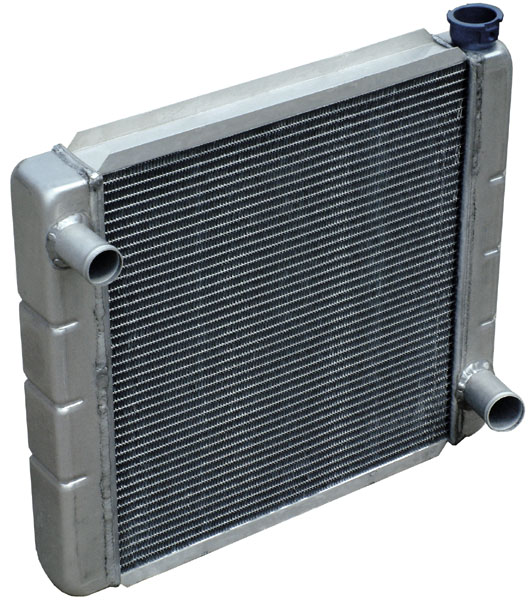|
Waterless Coolant
Waterless coolant is a glycol-based liquid substance that does not contain water. Its boiling point of is higher than that of water-based coolants and it resists the formation of corrosion. The substance was invented to circumvent the problems of vaporizing water. When water vaporizes, it retains only 4% of its thermal conductivity. Water-based coolants are safe at temperatures below the boiling point of water to maintain the pressure of the system. Waterless coolant has environmental benefits, including reducing the use of cooling fans and therefore improving fuel economy. The coolant does not generally need changing, reducing the hazardous waste following repeated coolant flushes. Automotive use Waterless coolant is most prominently used in the cooling systems for motorsports, classic car, All-terrain vehicle, ATVs, UTVs, snowmobiles and older cars. Older cars often have non-pressurized cooling systems, and the water-based coolant can boil and overflow. Traditionally, this issu ... [...More Info...] [...Related Items...] OR: [Wikipedia] [Google] [Baidu] |
Glycol
A diol is a chemical compound containing two hydroxyl groups ( groups). An aliphatic diol may also be called a glycol. This pairing of functional groups is pervasive, and many subcategories have been identified. They are used as protecting groups of carbonyl groups, making them essential in synthesis of organic chemistry. The most common industrial diol is ethylene glycol. Examples of diols in which the hydroxyl functional groups are more widely separated include 1,4-butanediol and propylene-1,3-diol, or beta propylene glycol, . Synthesis of classes of diols Geminal diols A geminal diol has two hydroxyl groups bonded to the same atom. These species arise by hydration of the carbonyl compounds. The hydration is usually unfavorable, but a notable exception is formaldehyde which, in water, exists in equilibrium with methanediol H2C(OH)2. Another example is (F3C)2C(OH)2, the hydrated form of hexafluoroacetone. Many gem-diols undergo further condensation to give dimer ... [...More Info...] [...Related Items...] OR: [Wikipedia] [Google] [Baidu] |
Classic Car
A classic car is typically described as an automobile 25 years or older, although a car's age is not the only requirement it must meet before being considered a "classic." However, a standard criteria for recognizing cars as classics does not exist, since different countries use their own rules and have their own regulations for classifying potential cars. Despite this, a common theme is that an older car of historical interest becomes collectible and tends to be restored rather than scrapped. Organizations such as the Classic Car Club of America (CCCA) maintain lists of eligible unmodified cars called "classic." These are described as "fine" or "distinctive" automobiles, either American or foreign-built, produced between 1915 and 1948. Post-World War II classic cars are not precisely defined, and the term is often applied to any older vehicle. Recognition of classic status Australia Australia has two main classic car registration categories: the Historic Vehicles Scheme (HV ... [...More Info...] [...Related Items...] OR: [Wikipedia] [Google] [Baidu] |
Ethylene
Ethylene (IUPAC name: ethene) is a hydrocarbon which has the formula or . It is a colourless, flammable gas with a faint "sweet and musky" odour when pure. It is the simplest alkene (a hydrocarbon with carbon–carbon bond, carbon–carbon double bonds). Ethylene is widely used in the chemical industry, and its worldwide production (over 150 million tonnes in 2016) exceeds that of any other organic compound. Much of this production goes toward creating polyethylene, which is a widely used plastic containing polymer chains of ethylene units in various chain lengths. Production greenhouse gas emissions, emits greenhouse gases, including methane from feedstock production and carbon dioxide from any non-sustainable energy used. Ethylene is also an important natural plant hormone and is used in agriculture to induce ripening of fruits. The hydrate of ethylene is ethanol. Structure and properties This hydrocarbon has four hydrogen atoms bound to a pair of carbon atoms that are con ... [...More Info...] [...Related Items...] OR: [Wikipedia] [Google] [Baidu] |
Antifreeze
An antifreeze is an additive which lowers the freezing point of a water-based liquid. An antifreeze mixture is used to achieve freezing-point depression for cold environments. Common antifreezes also increase the boiling point of the liquid, allowing higher coolant temperature. However, all common antifreeze additives also have lower heat capacity, heat capacities than water, and do reduce water's ability to act as a coolant when added to it. Because water has good properties as a coolant, water plus antifreeze is used in internal combustion engines and other heat transfer applications, such as HVAC chillers and solar water heaters. The purpose of antifreeze is to prevent a rigid enclosure from bursting due to expansion when ice, water freezes. Commercially, both the ''additive'' (pure concentrate) and the ''mixture'' (diluted solution) are called antifreeze, depending on the context. Careful selection of an antifreeze can enable a wide temperature range in which the mixture remain ... [...More Info...] [...Related Items...] OR: [Wikipedia] [Google] [Baidu] |
Soluble
In chemistry, solubility is the ability of a substance, the solute, to form a solution with another substance, the solvent. Insolubility is the opposite property, the inability of the solute to form such a solution. The extent of the solubility of a substance in a specific solvent is generally measured as the concentration of the solute in a saturated solution, one in which no more solute can be dissolved. At this point, the two substances are said to be at the solubility equilibrium. For some solutes and solvents, there may be no such limit, in which case the two substances are said to be " miscible in all proportions" (or just "miscible"). The solute can be a solid, a liquid, or a gas, while the solvent is usually solid or liquid. Both may be pure substances, or may themselves be solutions. Gases are always miscible in all proportions, except in very extreme situations,J. de Swaan Arons and G. A. M. Diepen (1966): "Gas—Gas Equilibria". ''Journal of Chemical Physics'', ... [...More Info...] [...Related Items...] OR: [Wikipedia] [Google] [Baidu] |
Waste Management
Waste management or waste disposal includes the processes and actions required to manage waste from its inception to its final disposal. This includes the collection, transport, treatment, and disposal of waste, together with monitoring and regulation of the waste management process and waste-related laws, technologies, and economic mechanisms. Waste can either be solid, liquid, or gases and each type has different methods of disposal and management. Waste management deals with all types of waste, including industrial, chemical, municipal, organic, biomedical, and radioactive wastes. In some cases, waste can pose a threat to human health. Health issues are associated with the entire process of waste management. Health issues can also arise indirectly or directly: directly through the handling of solid waste, and indirectly through the consumption of water, soil, and food. Waste is produced by human activity, for example, the extraction and processing of raw mater ... [...More Info...] [...Related Items...] OR: [Wikipedia] [Google] [Baidu] |
Fuel
A fuel is any material that can be made to react with other substances so that it releases energy as thermal energy or to be used for work (physics), work. The concept was originally applied solely to those materials capable of releasing chemical energy but has since also been applied to other sources of heat energy, such as Nuclear power, nuclear energy (via nuclear fission and nuclear fusion). The heat energy released by reactions of fuels can be converted into mechanical energy via a heat engine. Other times, the heat itself is valued for warmth, cooking, or industrial processes, as well as the illumination that accompanies combustion. Fuels are also used in the Cell (biology), cells of organisms in a process known as cellular respiration, where organic molecules are oxidized to release usable energy. Hydrocarbons and related organic molecules are by far the most common source of fuel used by humans, but other substances, including radioactive metals, are also utilized. Fu ... [...More Info...] [...Related Items...] OR: [Wikipedia] [Google] [Baidu] |
University Of California, Los Angeles
The University of California, Los Angeles (UCLA) is a public university, public Land-grant university, land-grant research university in Los Angeles, California, United States. Its academic roots were established in 1881 as a normal school then known as the southern branch of the California State Normal School which later evolved into San Jose State University, San José State University. The branch was transferred to the University of California to become the Southern Branch of the University of California in 1919, making it the second-oldest of the ten-campus University of California system after the University of California, Berkeley. UCLA offers 337 undergraduate and graduate degree programs in a range of disciplines, enrolling about 31,600 undergraduate and 14,300 graduate and professional students annually. It received 174,914 undergraduate applications for Fall 2022, including transfers, the most of any Higher education in the United States, university in the United Stat ... [...More Info...] [...Related Items...] OR: [Wikipedia] [Google] [Baidu] |
Bugatti
Automobiles Ettore Bugatti was a German then French automotive industry, manufacturer of high performance vehicle, high-performance automobiles. The company was founded in 1909 in the then-German Empire, German city of Molsheim, Alsace, by the Italian-born industrial designer Ettore Bugatti. The cars were known for their design beauty and numerous race victories. Famous Bugatti automobiles include the Bugatti Type 35, Type 35 Grand Prix cars, the Bugatti Royale, Type 41 "Royale", the Bugatti Type 57, Type 57 "Atlantic" and the Bugatti Type 55, Type 55 sports car. The death of Ettore Bugatti in 1947 proved to be a severe blow to the marque, and the death of his son Jean Bugatti, Jean in 1939 meant that there was no successor to lead the factory. With no more than about 8,000 cars made, the company struggled financially, and it released one last model in the 1950s before eventually being purchased for its airplane parts business in 1963. In 1987, an Italian entrepreneur bought th ... [...More Info...] [...Related Items...] OR: [Wikipedia] [Google] [Baidu] |
Jay Leno
James Douglas Muir Leno ( ; born April 28, 1950) is an American television host, comedian, and writer. After doing stand-up comedy for years, he became the host of NBC's ''The Tonight Show with Jay Leno, The Tonight Show'' from 1992 until 2009 when Conan O'Brien took over as host. Beginning in September 2009, Leno started a primetime talk show, ''The Jay Leno Show'', which aired weeknights at 10:00 p.m. Eastern Time Zone, ET, also on NBC. O'Brien turned down NBC's offer to have Leno host a half hour monologue show before ''The Tonight Show'' to boost ratings amid reported viewership diminishing, which sparked the 2010 Tonight Show conflict, 2010 ''Tonight Show'' conflict that resulted in Leno's returning to hosting the show on March 1, 2010. He hosted his last episode of his second tenure on February 6, 2014. That year, he was inducted into the Television Hall of Fame. From 2014 to 2022, he hosted ''Jay Leno's Garage,'' and from 2021 to 2023, hosted the revival of ''You Be ... [...More Info...] [...Related Items...] OR: [Wikipedia] [Google] [Baidu] |
Radiator
A radiator is a heat exchanger used to transfer thermal energy from one medium to another for the purpose of cooling and heating. The majority of radiators are constructed to function in cars, buildings, and electronics. A radiator is always a source of heat to its environment, although this may be for either the purpose of #Heating, heating an environment, or for cooling the fluid or coolant supplied to it, as for automotive #Engine cooling, engine cooling and Heating, ventilation, and air conditioning, HVAC dry cooling towers. Despite the name, most radiators transfer the bulk of their heat via convection instead of thermal radiation. History The Roman hypocaust is an early example of a type of radiator for building space heating. Franz San Galli, a Prussia, Prussian-born Russian businessman living in St. Petersburg, is credited with inventing the heating radiator around 1855, having received a radiator patent in 1857, but American Joseph Nason and Scot Rory Gregor developed a ... [...More Info...] [...Related Items...] OR: [Wikipedia] [Google] [Baidu] |







